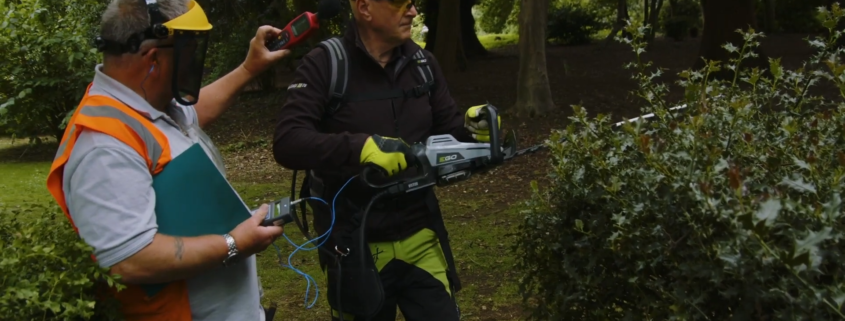Results show some petrol-powered tools are up to 3 times louder than battery alternatives
The loud chugging of petrol garden tools is a familiar sound to professional gardeners as they utilise machinery to deliver the best results on every job. But while that loud noise is temporary, its effects can last much longer than the time it takes to mow a lawn or trim a hedge. That’s because long-term exposure to high levels of noise and vibration can trigger various health problems, from hearing loss to cardiovascular troubles. To help make professionals aware of these dangers, EGO Power Plus, as part of its Challenge 2025 initiative, has put a host of battery-powered and petrol-powered tools to the test to understand which produce the greatest – and most harmful – levels of noise and vibration.
Everyday tools such as hedge trimmers and lawn mowers, through to more advanced chainsaws, all share the same purpose – they’re designed to support the maintenance of outdoor spaces and, ultimately, enhance these environments. In recent years, we’ve seen a surge in uptake of battery-powered tools, thanks largely to their ability to deliver the same performance without the emissions, fuss, and fumes of traditional petrol-powered equipment.

Results show some petrol-powered tools are up to 3 times louder than battery alternatives
And while battery-powered tools are already helping to avoid unnecessary emissions being released into our green spaces, new research from EGO Power Plus confirms that most are also quieter and safer to use.
Petrol-powered tools are up to 3 times louder than battery alternatives
To understand the difference between petrol-power and battery-power when it comes to noise and vibration, independent tests were carried out across five product categories: rotary mowers; hedge trimmers; line trimmers; leaf blowers and chainsaws. For each category, one petrol and one battery tool were tested, each comparable in terms of performance and cost. To achieve accurate results, each tool was tested in operation by Earlsmere, a leading vibration and noise testing company, to measure the ‘real-life’ levels of noise and vibration which can be expected when in use.
When measuring noise, a logarithmic scale is used which means that in decibel terms, a doubling in perceived loudness corresponds to roughly an increase in 10 dB(A). Across every category, EGO’s tools produced less noise than their petrol-powered counterparts. For line trimmers, which are the loudest garden tool of all those tested, the petrol-powered tool generated an alarming 103.8dB(A), which, to the normal ear, sounds almost three times louder than EGO’s BCX3800 line trimmer. For context, 100dB(A) would be the same as standing 305 metres from a jet taking off*. While the 88dB(A) of the EGO line trimmer still exceeds the HSE’s exposure limit* by 1dB(A), it is evidence that battery power is helping to move the industry towards a quieter and safer future. In real terms, reducing noise levels from 100dBA to 85dBA means the user can be exposed to noise for approximately 3 hours longer before risk assessment is even required. At the other end of the spectrum, EGO’s mower was proven to generate just 74.7dB(A), 10.3dB(A) beneath the exposure limit level, which is 30% quieter than a market-leading petrol equivalent.
Of all the tools tested, four petrol-powered tools exceeded the daily noise exposure limit of 87dB(A), with two generating noise levels of more than 100dB(A). Meanwhile, two battery-powered tools operated below or within the recognised limits, and zero battery-powered tools exceeded 94dB(A).
When it comes to vibration, three out of five battery-powered tools came in under the daily vibration exposure limit of 2.5m/s2 , set by HSE, at which vibration becomes a concern. Of the petrol tools, however, the opposite is true, with four out of five found to exceed this exposure limit. This means the majority of petrol-powered tools tested cannot be used for the entire duration of a working day (8 hours) without causing potential health concerns for operators.
For both noise and vibration, daily limits are set which should not be exceeded. These are set out within numerous work-related safety documents, including the Control of Noise at Work Regulations (2005), and for vibration, in the Control of Vibration at Work Regulations (2005).
The reality of long-term exposure to noise and vibration
Prolonged exposure to high levels of noise and vibration is known to have health implications for operators. Related conditions include: hearing loss, whether partial or full, temporary or permanent; Raynaud’s, affecting the blood circulation in the hands and fingers; and even cardiovascular problems, which the European Environment Agency estimates contributes to 48,000 premature deaths every year.
With that in mind, managing the effects of noise and vibration for professional gardeners is hugely important, particularly as they are exposed for prolonged periods in their everyday work.
To create safer working environments, there are several things that can be done. At the most basic level, ensuring adequate personal protective equipment (PPE) is worn is essential – particularly in reducing the potential impacts of noise. Beyond this, understanding the noise and vibration exposure levels, and the tools which are potentially most harmful in relation to the tasks being undertaken, can inform how frequently tools are used.
For instance, if mowing lawns for the majority of the working day is common, switching to battery-power would significantly reduce harmful exposure. This is because EGO’s mower can be used for 12.5 hours before reaching the lower action level for vibration and generates 74.7dB(A) for every hour of use. A comparable petrol mower will reach the same vibration level in less than 5 hours and exceed the lower action level of 80dB(A) every hour.
Understanding which tools are most damaging to health should inform decisions around switching from petrol-power to battery. Plus, with comparable levels of performance, alongside zero emissions and cost benefits, battery-powered tools are a viable alternative for every professional gardener.
To see the full noise and vibration test results, see EGO’s latest video at https://youtu.be/jiskHm0rkNY.
*The Control of Noise at Work Regulations 2005 (Noise Regulations 2005): Exposure limit value of 87 bB(A)
*Jet taking off: https://www.chem.purdue.edu/chemsafety/Training/PPETrain/dblevels.htm
For the latest industry news visit landscapingmatters.co.uk/news
Get all of the big headlines, pictures, opinions and videos on stories that matter to you.
Follow us on Twitter and Instagram for fun, fresh and engaging content.
You can also find us on Facebook for more of your must-see news, features, videos and pictures from Landscaping Matters












